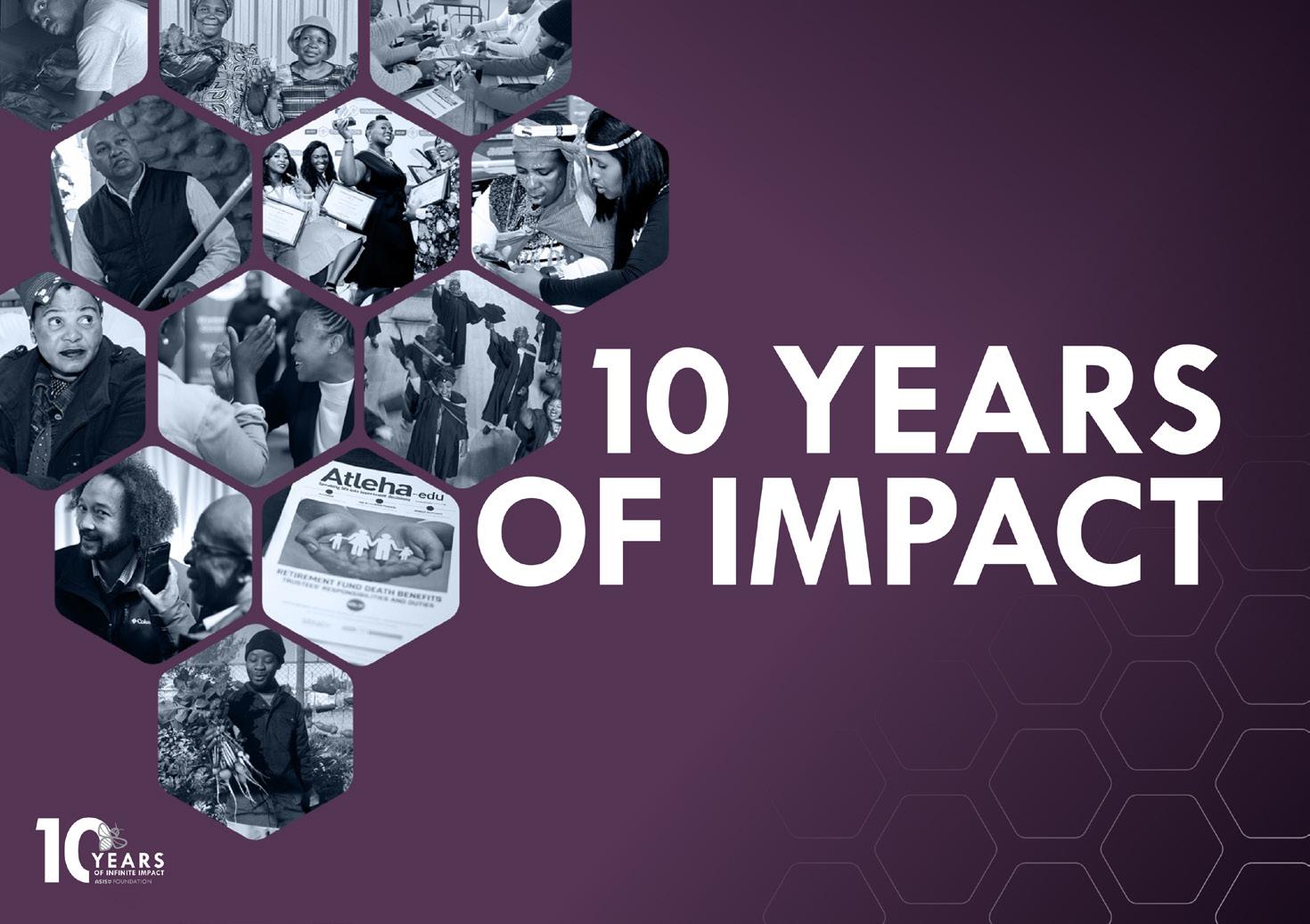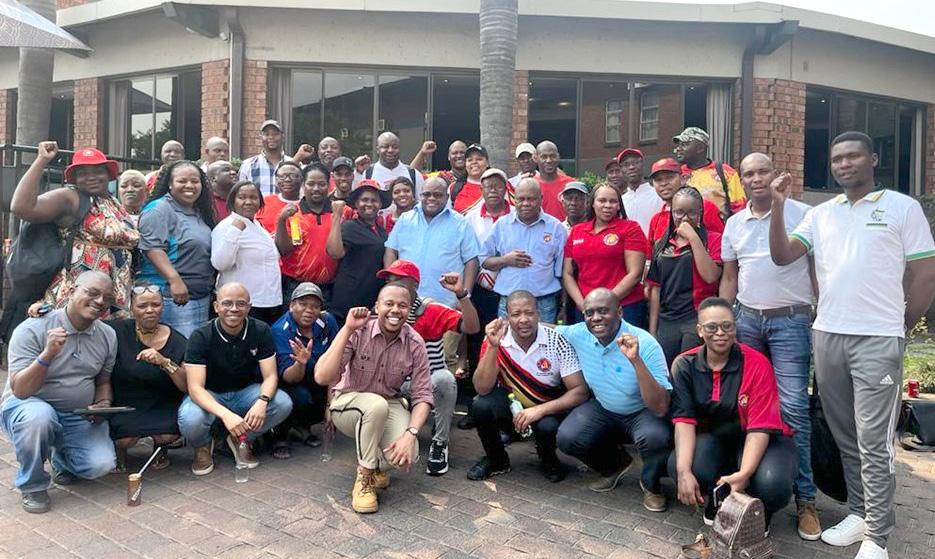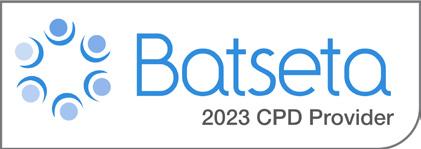







The ASISA Academy, in partnership with the ASISA Foundation, is offering the following high quality, fully-sponsored, independently delivered Retirement Fund Trustee Education Workshops to South African Retirement Fund Principal Officers and Trustees. The ASISA Academy is an accredited CPD provider for the Batseta Council for Retirement Funds with each workshop carrying 3 Batseta CPD credits.
1.
2.

How much do you save per month? About 20% of your salary as the 50/30/20 budget rule recommends or is it closer to five per cent in a good month? Or perhaps even less … If the latter, don’t feel bad. In 2022 the household savings rate in South Africa was only 0,2% according to the 2023 Sanlam Benchmark Survey.
In general, South Africa has a poor savings culture. Many South Africans are cash strapped and simply don’t have enough money to prioritise emergency savings.
This situation has been a long time coming and was exacerbated by the Covid pandemic when many people had to dip into their savings just to survive. The prevailing high inflation and interest rates have also worsened an already precarious situation. According to the 2023 FinScope Consumer Survey the main reason people borrowed money in 2022 was to pay for living expenses, specifically food and groceries. What not to say about an unexpected financial emergency?
In the same vein, about 75% of the respondents in the 2023 Sanlam Benchmark research contribute to some kind of retirement savings plan. The traditional primary goal and design of a retirement fund are to secure an income for members once they retire; it was not designed for early access in case of a financial crisis. Payments from a retirement fund
should only take place in the case of the withdrawal, death or retirement of a fund member.
However, many members tend to withdraw from their retirement savings before retirement for that exact reason. Often members quit their jobs to access these savings to pay for outstanding debts or to pay for household hardships. This practice was commonly referred to as “leakage from the system”. This brings us to our first challenge – allowing members to have some access to savings without placing their employment at risk.
Because of frequent early withdrawals, only about ten per cent of fund members can maintain the same lifestyle after retirement. Herewith, the second challenge – the need for greater preservation of retirement income.
The government tried various measures to encourage members to not cash out their savings before retirement, such as imposing a substantial tax on withdrawals before retirement. However, the high tax rate did not appear to be a successful deterrent (see graph 1).
To address the above challenges, the government has since 2012 initiated a retirement reform programme out of which the two-pot system was born.
700 000
The number of members cashing out a withdrawal lump sum before retirement.
R12 billion
Tax paid on withdrawal lump sums.
R78 billion
The approximate amount taken out of the retirement system each year. Graph
Long-term retirement savings
Access to savings in case of an emergency
Ultimately, the two-pot system was designed to help South Africans strike a balance between long-term retirement savings goals while providing prior access to retirement savings for emergencies and life’s other unexpected events.
The retirement fund system is governed by an established body of legislation, principally codified in the Pension Funds Act promulgated in 1956, as well as the Income Tax Act of 1962. Since 2012, National Treasury has amended numerous provisions of the Income Tax Act to address the competing challenges of prior access and preservation at the same time. Here’s the history.
National Treasury releases a discussion paper for public comment. This paper highlighted the need for preservation and gave birth to large-scale industry developments, such as T-day, P-day, and the default regulations intent on helping members to preserve retirement savings.
The 2022 Draft Revenue Laws Amendment Bill containing proposed amendments dealing with the “two-pot” retirement system is released for public comment.
A revised Revenue Laws Amendment Bill and a Revenue Administration and Pension Laws Amendment Bill are released for public comment.
The amendments to the Revenue Laws Amendment Bill must be approved by Parliament and signed into law by the President. The Revenue Administration and Pension Laws Amendment Bill will be replaced with a Pension Funds Amendment Bill which is still to be tabled and processed in Parliament. Government introduces Tax-free savings accounts (TFSAs) to encourage South Africans to save more. Currently, the maximum amount you can contribute to a TFSA is R36 000 per year (or R3 000 per month via debit order) and the maximum lifetime contribution is R500 000. The traditional retirement system is aligned so that the tax benefits for all three funds – provident funds, pension funds and retirement annuities – are the same. You can claim a tax deduction up to 27,5% of your pensionable income to a maximum of R350 000 per year.
From 1 March – called T-day – the same rule applies to all retirement funds (provident, provident preservation, pension funds and retirement annuities): At retirement two thirds of your savings must be invested again (annuitised) to pay out a regular pension. Before, some funds allowed you to withdraw all your savings in cash at retirement. (Existing members of provident and provident preservation funds retained their vested rights prior to T-Day.)
On 15 December government publishes a discussion document titled Encouraging South Africans to save more for retirement, which proposed a new retirement fund regime in the form of a “two-pot” system.
National Treasury responds to stakeholder comments in Parliament on 25 October. Among others, Treasury recommended to Parliament that the implementation date for the two-pot system is pushed out by a year to 1 March 2025.
On 4 December Parliament’s finance committee agrees to a compromise implementation date of 1 September 2024.
• Daily Maverick: Two-pot retirement regulations have sweet and sour ingredients; South Africans are borrowing money to fund groceries — study
• National Treasury: Encouraging South African households to save more for retirement; Retirement fund reform discussion paper
• Sanlam: Member Alert Retirement Reform Changes
• 2023 Sanlam Benchmark Insights Report
1 2 3 4
1 September 2024


This is the proposed implementation date.

Your retirement savings up to 31 August 2024, i.e. your existing retirement fund savings. All the existing "old" rules apply, e.g. you may access retirement savings when you resign from your employment, you may make a one-off withdrawal before retirement (preservation fund members), and at retirement one third may be taken as a cash lump sum while two thirds must be used to purchase an annuity.
From 1 September 1/3 of your contributions go here.
There will be an opportunity to “seed” your savings pot with ten per cent, limited to R30 000, of your vested pot (as of 31 August 2024), which can be accessed immediately on the implementation date.
You may withdraw from your savings pot once per tax year – from a minimum of R2 000 to the full amount. For the purposes of SARS, the amount will be added to all your other income and taxed at your marginal tax rate (PAYE tax rates). You may also transfer money from the savings pot to the retirement pot tax-free. However, a transfer from the retirement pot to the savings pot is not allowed.
No amounts may be paid to you out of this pot until normal retirement age, not even if you resign from your job or if you are retrenched.
On retirement, you must buy an annuity with the entire amount in the retirement pot. Amounts less than the minimum amount (of R247 500) in this pot may be taken as a lump sum which will be exempt from tax.
It’s compulsory. The changes will apply to all retirement funds, including public sector funds such as the Government Employees Pension Fund and the Transnet funds. Certain so-called “legacy” retirement annuities will be exempt. (In general, legacy retirement annuities refer to policies – entered before 1 September 2024 – from life insurance companies that have additional features, such as universal life policies with life or lump-sum disability cover.)
55 Plussers have a choice. Provident fund members who were 55 years and older on 1 March 2021 will, by default, be excluded from the two-pot regime. They must choose to opt in.



You will be able to transfer money between the pots. There will be a once-off transfer of ten per cent or R30 000 (whichever is lesser) of your accumulated retirement savings (or vested pot) as at 31 August 2024 to the savings pot, which can be accessed immediately on the implementation date.



You can withdraw from a minimum of R2000 to the full amount.
You may not withdraw from the retirement pot until you reach normal retirement age, not even if you resign or if you are retrenched. When you retire, you have to buy an annuity (including a living annuity) with the full amount in the retirement pot, subject to the minimum amount required to buy an annuity as set out below. (If you die whilst a member of a retirement fund, the money in your retirement pot will be paid to your beneficiaries.)
There’s one exception to the rule. If at retirement your total retirement savings are equal to or less than R247 500, you may take the whole amount in cash. This is called the R247 500 de minimis threshold which will be exempt from tax.
Let's explain:
At retirement Sibusiso has R150 000 in his vested pot and R60 000 in the retirement pot.

The amount will be added to your other taxable income for the year and taxed at your marginal tax rate. + <
Sibusiso can take the full R165 000 as cash.

You still enjoy the tax benefits of being a retirement fund member. You can claim a tax deduction on these contributions, namely the lesser of R350 000 and 27,5% of remuneration or taxable income.
Think of your future self. Although the government has made these changes to give members access to savings before retirement, it is never in your best interest to withdraw monies from your retirement fund before your retirement. You will be paying tax on the amount you withdraw and have less cash and income when you retire. It is recommended that you keep all your retirement savings invested for retirement, including any savings in your savings pot.
The two-pot system is not a golden bullet and cannot solve all our financial woes. Its effectiveness depends on members’ focus and discipline when it comes to saving, as well as the period they are obliged to contribute two thirds of their monthly contributions to the retirement pot. Let’s look at two scenarios:
For this example, we assume the following:
An annualised investment return of 11%
A contribution rate of of 11%
Salary growth of 3%
She joins a retirement fund at age 20.
Salary
Scenario 1
Khumo takes seed capital from the vested pot on 31 August 2024 and withdraws from the savings pot every year.



Khumo resigns and changes jobs every 7 years until the age of 50, and every time she resigns she withdraws her total retirement fund savings.
Under the current regime
R2,7 million in retirement savings
Under the two-pot system
Scenario 2
Khumo withdraws from the savings pot only.

Scenario 3
Khumo preserves all her assets.
R8,6 million R14,8 million R19 million
We assume: An annualised investment return of 11% A contribution rate of of 12%
Salary growth of 3%
He joins a retirement fund at age 20.
1 September

R0 Vested pot
Scenario 1
This infographic is based on a similar one in the 2023 Sanlam Benchmark Insights Report. 1974 2024
He is 51 years old when the two-pot is implemented. Sbu resigned every 7 years until aged 50.
Under the two-pot system
He stops resigning and cashing out his retirement savings, but continues to withdraw from the savings pot.
R1,4 million
That is a stark difference from the R19 million he would have saved had he been fully preserving throughout his career.
Scenario 2
He stops resigning and cashing out the savings pot and preserves all his assets until retirement.
R1,7 million
Even if Sbu preserves his savings pot it doesn’t make much of a difference. Sbu’s situation reflects that of many current, especially older, members of retirement funds. His case illustrates an important point: The best way for Sbu and Khumo to ensure a comfortable retirement – and ultimately the success of the two-pot system – is to make long-term contributions to the forced preservation retirement pot, which cannot be accessed before reaching retirement age.
REFERENCES
• BDO South Africa: More tweaks for the two-pot
• Moonstone Information Refinery: GEPF and other public sector funds ‘will be part of the two-pot system’
• National Treasury: Publication of the draft legislation for the “two-pot” retirement system for public comment
• Old Mutual: Two-Pot guide for employers, HR practitioners and intermediaries
• Momentum: Legal update 4 of 2023: The impact of the new two-pot retirement system
1. What are the tax implications if I withdraw from the savings pot?
You will be taxed on the amount you withdraw from the savings pot every year. The amount will be added to your other taxable income and the tax payable will depend on the SARS tax rate that applies to that income band, i.e. the member’s marginal tax rate. At the end of the tax year after your SARS assessment any excess tax will be refunded or additional tax might be due. Industry experts warn that the additional income from the savings pot could push an individual into a higher tax bracket or over the tax threshold for the first time.
2. What are the tax implications for my savings pot at retirement?
On retirement, you may take the balance in your savings pot as cash. The amount will be taxed according to the retirement lump-sum tax table, and not at your marginal tax rate. If you do not take any money from your savings pot before you retire, you could potentially get an amount of up to R550 000 tax-free from that pot.
3. What if I belong to a definedbenefit fund (DB fund)?
The current proposal is that, from September 2024, DB funds calculate the contribution to the savings pot based on one third of your pensionable service (i.e. number of years worked), and the contribution to the retirement pot based on two thirds thereof. Or another method approved by the FSCA.
4. What happens to my pots if I move to another retirement fund?
The pots cannot be separated and are one account in your name. When you resign or move your account, you cannot separate the pots. You will have to move your entire account (all three pots) to the new fund.
5. Can I access any savings if I am retrenched?
National Treasury has not yet communicated the treatment of retirement savings in retrenchment. Legislation dealing with withdrawals from retirement savings will only be finalised in the second phase of the two-pot system. In all likelihood, you will be able to withdraw funds in your vested pot and savings pot, provided that you have not already made a withdrawal, but not from your retirement pot.
Let’s explain:
Kgomotso is 27 years old and earns R7 900 per month. His taxable income of R94 800 per year is just under the government’s R95 750 tax threshold, which means he doesn’t have to pay tax. His payslip also does not include a deduction for PAYE tax.
He opts to withdraw R5 000 from his savings pot in September. This pushes his taxable income to R99 800 and he is now no longer under the tax threshold referred to above. He is liable for 18% tax on the difference of R4 050, which comes to R729. Once he files his tax return in July of the following year the R729 will appear on his payslip as a tax deduction.
Kgomotso's income + savings
0% Tax
Kgomotso's income
Let’s explain:
Mandla has been in service for two-and-a-half years (30 months) and his retirement contribution is valued at R150 000. The fund seeds his savings pot with R15 000, which is 10% of his benefit. The fund will reduce the member’s pensionable service by 10% to compensate for the withdrawal. The pensionable service date will be moved forward by three months (10% of 30 months) to achieve this.
6. What happens if I emigrate?
In general, you are allowed to withdraw from the vested, savings and retirement pot subject to the three-year rule – you must have been non-resident for a minimum of three years. The vested pot will then be taxed in accordance with the pretwo-pot tax provisions, the savings pot will be included in your taxable income, and the retirement pot will be taxed according to the lump sum withdrawal tables.
• Momentum: Legal update 4 of 2023: The impact of the new twopot retirement system
• Old Mutual: Our view on the recent updates to the two-pot retirement system
• Today’s Trustee: Balancing the unintended consequences of the two-pot system
30 years old
Please

Under the two-pot system Tau has various options he can take, each with a different outcome. Here’s an example of how Tau’s choices can affect his finances.
Ten per cent of Tau's accumulated retirement savings is transferred to seed his savings pot.
1 September 2024
Tau starts paying 1/3 of his monthly contribution into the savings pot and 2/3 into the retirement pot.
Tau withdraws R21 000. His yearly income is R132 000, meaning he must pay 18% tax on the withdrawn amount which comes to R3780. In effect, he only receives R17 220 of the savings pot money.



Tau keeps R21 000 in savings pot.



A year later on
1 September 2025



= R200 988



= R221 988
Note the difference in the savings pot if Tau suddenly has a financial emergency.
we have simplified the calculations for illustrative purposes. For example, the annual investment return is not included. This depends on various
and 11%.
The two-pot retirement system has been widely praised by the industry, as it improves the preservation of retirement savings and ultimately provides the pension fund industry with more assets under management. Members and labour have heralded it as a welcome relief. However, the rapturous applause quickly dissolves into a tentative clap, as questions surrounding industry readiness, conflicting messages and fund liquidity arise. Meet the main challenges.
1
Initially, the implementation date was set for 1 March 2024 which was an extremely tight deadline between legislation and implementation. Industry leaders called the two-pot system 'the most complex legislation the retirement industry has ever had to deal with', saying ideally it would require 18 months upon legislation to finalise implementation. In October this year, the National Treasury proposed delaying implementation by one year until 1 March 2025. At the time of going to print Parliament’s finance committee and Treasury agreed on a compromise implementation date of 1 September 2024. It remains to be seen whether the extra six months will be adequate for the overhaul of the retirement industry.
2How will administrative systems, traditionally designed for staggered long-term savings withdrawals, be geared for the annual pre-retirement withdrawal rush? Will SARS be able to provide individual tax directives for yearly savings pot payouts? The changes in both of these systems are a huge administrative undertaking, i.e. creating and approving new forms, processes and policies, as well as training staff.
3The increase in member withdrawal will require large-scale automation. Old Mutual funds expect one million members to withdraw money. To streamline such a process, funds will have to ensure the claims process is fraud-proof, digitised, quick and easy.
4Retirement funds will need to restructure their investments for liquidity reasons. For some, it will require an overhaul of investment strategies for the savings pot, ensuring liquid short-term investment solutions through income assets, with the retirement pot housing riskier, long-term growth assets.
5Funds will need to have complex authorising amendments to their rules approved by the regulators before anxious members can access a withdrawal from their savings pots.
6Member readiness and education are vital. This will require largescale communication roll-outs by retirement funds. This must also include orienting and empowering members to understand their new threepot benefit statements, contributions, and investment returns, and the impact of irreversible decisions.
7Not everybody will win in the twopot system. Younger members who invest most of their contributions will benefit most. Members who are closer to retirement and who have been cashing out their savings regularly could be worse off. In the past, such members would have had to resign (which does serve as a bit of a deterrent) to access their savings. Under the new system, they can easily withdraw from their savings pot once a year.
• Liberty: What You Need To Know About The Two-Pot Retirement Saving System
• Old Mutual: Two-pot update: Bringing more certainty to the unknowns
• SADTU: The Two-pot Pension system / What are the rules for pension withdrawal?
• Today's Trustee, June/August 2023: Two pots: can it be done by March? & The 10 big unknowns of the two-pot system




This workshop gives retirement fund trustees and principal officers an overview of employee death benefits within the context of retirement funds. Topics include the objectives of death benefits in reference to the Pension Funds Act, trustees’ duties, beneficiary identification, definition of dependants, benefits payments and member communications.
THE WORKSHOP’S 6 LEARNING AREAS INCLUDE
1. BACKGROUND AND TRUSTEE DUTIES
2. IDENTIFICATION AND PROCESS
3. DEPENDANT DEFINITION
4. BENEFIT PAYMENTS
5. MEMBER COMMUNICATIONS OF DEATH BENEFITS
6. JURISPRUDENCE, LEGAL & REGULATORY UPDATE
“It has been very valuable. I am very excited about the knowledge I have gained. Great course!”
“Great lecturers from the industry, who have a wealth of knowledge to share. I thoroughly enjoyed it.”
“The programme has broadened my perspective in terms of the actual industry ~ I am learning so much. It has been a great experience so far.”

1
Liquidity is key. Trustees need to balance the risk levels of their investment strategy to meet the liquidity and preservation requirements of the two-pot system. Members will be allowed to withdraw yearly; therefore, a large amount of cash needs to be available.
2Rethinking investment strategies. Current investment strategies will have to be reviewed to accommodate both pots and to manage risk. Members wishing to withdraw their funds could crystalise their losses if the fund’s aggressive strategy upon withdrawal has been underperforming. If retirement funds were invested in alternative or private equity investments, liquidity at the point of withdrawal could be an issue.
Profiling a lower-risk portfolio for the savings pot relative to the retirement pot could prejudice members who remain invested until retirement age and who would face lower returns on their funds. One way for trustees to mitigate this is to consider a lower-risk profiled savings pot, where the retirement pot could be invested more aggressively to compensate for the expected lower return.
3Allocation choice. Another way to not jeopardise members who stay invested is to give them more choice. Trustees could consider providing members with choice portfolios for the savings pot, and a 'default' savings strategy for members who don't wish to choose their own portfolios. This is risky as trustees would need to consider member profiles and their depth of financial knowledge, but it could be an option for mega funds that have higher governance models.
4Educating members. How will the retirement fund provide informative and engaging member education, especially regarding the importance and compound effect of keeping savings invested? Withdrawal should only be an option in a crisis. The tax implications of withdrawals and the high risk of withdrawal fraud should also be highlighted. Trustees should consider retirement counselling beyond that given when members leave a fund.
5Eco-system readiness. How will your retirement fund’s administrative systems, designed for long-term savings, adapt to the annual withdrawals from the savings pot? For example, can the administrators handle the expected rush of claims in the first few months after implementation? Preferably this process should be automated. Trustees should advocate the digitisation of the member claims process and the creation of a new benefit statement that includes the three pots and their totals. Trustees need to consider how they can best manage any potential delays or glitches with SARS regarding member tax directives for withdrawals.
6
Time is tight. One of the critical aspects of the implementation is a complex amendment to the registered fund rules.
Once the bill has been signed into law, trustees have only a short time to amend the fund rules to allow prior access to a portion of the savings pot. The Financial Sector Conduct Authority office must then register and approve such rule amendments for approximately 1 000 registered retirement annuity, preservation, pension and provident funds.
• Liberty: What you need to know about the two-pot retirement saving system.
• Moonstone: Two-pot retirement system: who will be the winners and the losers?
• Sasfin: A Two Pot Retirement System … the lesser of two evils.
The ASISA Foundation celebrates 10 years of partnerships and collaborations that have enabled it to deliver quality financial education to South Africans and sounds a call for increased sector-wide collaboration.
The infinite impact of the ASISA Foundation’s work over the first 10 years is a result of collaboration, partnerships, funding, legislation and passionate participants, all with a common goal of transformation through financial education.
Read the remarkable story of the effect of infinite impact from individuals to families, communities across South Africa.
Watch what the original founders and others have to say about the journey of financial education over a decade.

www.asisa.org.za/foundation/celebrating-10-years




As you might know, Section 37C of the Pension Funds Act is a complex piece of legislation to navigate. It sets out how retirement fund death benefits should be distributed and requires retirement fund trustees to make decisions that can materially impact beneficiaries.
With funding from Strate and the ASISA Foundation, we have produced an educational publication focusing on Section 37C. Retirement fund death benefits: Trustees’ responsibilities and duties takes an in-depth look at why this legislation is in place and what trustees must do to ensure they meet their obligations under Section 37C.
Some of the key topics we cover include:
• Implications for trustees under Section 37C
• The process of identifying and tracing dependants
• How to make fair and equitable distributions
Read this publication



There is currently a pot of R47 billion in the South African economy in the form of unclaimed benefits – money owed to ordinary South Africans.
This has created an interesting conundrum in South Africa. On the one hand, there is a huge pot of unclaimed benefits and on the other hand, citizens who desperately need an income. The solution seems simple. Find the beneficiaries and pay out the money. Unfortunately, this relationship is complicated.
Read about:
• Who benefits from unclaimed benefits ...?
• The 13 recommendations of the FSCA discussion paper
• The role of trustees in the tracing process
• Unclaimed benefits and Africa’s largest pension fund
• Unpaid vs unclaimed
• The history of unclaimed benefits
Read this publication


In Sesotho, when you tell someone to “Atleha” you are telling them to prosper. By combining “Atleha” and “edu” we want to contribute to quality financial education.
Our purpose at Atleha-edu, a non-profit company (NPC), is to help ordinary South Africans save and invest for a better tomorrow. We do this through Financial Sector Code (FSC)-compliant awareness and interactive education programmes focused on retirement fund trustee, principal officer, management committee member, and fund member awareness and education initiatives.

We provide accessible, quality consumer financial educational (CFE) content via:
Atleha-edu’s CFE offers the following benefits:
• Retirement Fund Trustee and Member education on topical retirement fund issues, as envisioned by the Financial Sector Conduct Authority (FSCA) and Financial Sector Code (FSC)
• A mixture of educational publications, short articles, video and audio content (including translations into various African languages, such as isiZulu, Sesotho and isiXhosa)
• Educational content accredited for BATSETA Continuous Professional Development (CPD)
• All content is available at no cost
• No funder or service provider product marketing as per FSTC Guidance Note 500
















Per the requirements of FSTC Guidance Note 500, all Atleha-edu resources on the Atleha-edu website are made available to retirement fund trustees, principal officers and members at no cost. Atleha-edu has full editorial control over educational content and funder branding.
• Atleha-edu NPC receives FSC Consumer Financial Education funding from a number of industry partners and funders.
• We are most grateful to the ASISA Foundation, ASISA Academy, Alternative Prosperity Foundation and BATSETA Council of Retirement Funds for South Africa for their strategic partnership and funding and implementation support.
• A full list of our funders is available via www.atleha-edu.org/partner-with-us




All our Atleha-edu educational content and initiatives are aligned to a formal Theory of Change and Monitoring Evaluation and Learning (ME&L) programme. An external Monitoring and Evaluation service provider reviews our ME&L programme on an annual basis. The ASISA Foundation also reviews all Atleha-edu educational content and initiatives where it has specifically been a funder or co-funder.
Per the FSC requirements, an independent third-party service provider annually reviews all our Atleha-edu educational content and CFE initiatives and issues Atleha-edu NPC with an annual Independent Competent Persons Report (ICPR). The ICPR is provided to CFE funding partners who are then able to use the Atleha-edu ICPR when claiming FSC Scorecard points for their Consumer Financial Education spend through Atleha-edu NPC.
Sign up via www.atleha-edu.org/trustee-education to receive free FSC-compliant educational content from Atleha-edu NPC via www.atleha-edu.org as well as via a weekly Atleha-edu educational email on a Friday at 11h00.
Contact us for more info about Atleha-edu NPC
Email: info@atleha-edu.org | Phone: 021 851 0091




Atleha-edu Consumer Financial Education initiatives are accredited for Continuous Professional Development (CPD) in partnership with the Batseta Council of Retirement Funds for South Africa.
To register your CPD credits for having read this Atleha-edu Consumer Education publication, please complete the following quiz and return this completed form via email to: info@atleha-edu.org or post it to: Atleha-edu, Postnet Suite 272, Private Bag, Somerset West, 7129 True False
Example question: Please choose the correct answer.
True or false? Foreign investment limits were revised upward by National Treasury in February 2022. x
1. Fill in the missing words. From 1 September 2024, your retirement savings will be divided into a _____________________ pot, _____________________ pot and ________________________ pot.
2. The savings pot will be seeded once from their accumulated retirement savings (as at 31 August). This amount will be limited to a maximum of R____________________.
3. True or false? The two-pot system is compulsory for all members of all retirement funds.
6. True or false? You should withdraw from your savings pot every year whether to buy a car or a flatscreen television or to pay for a birthday party.
7. If you withdraw from your savings pot, the amount will be added to your other income for the year and taxed at your ____________________ which starts at ___________%.
4. Choose the correct answer. Up to what percentage of your savings pot can you withdraw each year?
You can only withdraw R2000.
10% 100%
5. True or false? You can withdraw from your retirement pot if you are retrenched.
8. True or false? The three pots cannot be separated and are one account in your name. If you move to another retirement fund all three pots must be moved.
9. One of the key challenges in the two-pot system that retirement funds must address is their investment strategies. Trustees will need to balance the risk levels of their investment strategy to simultaneously meet the _________________ and _______________ requirements of the two-pot system.
10. Complete the sentence. If at retirement, your total retirement savings is equal to or less than R____________, members can take the money in the retirement pot in cash. This is called the R________________ de minimis threshold.